
Have you ever noticed your face turning red during a shoulder stand or handstand? That happens because your body is upside down, and gravity pulls more blood toward your head.
But then, why don’t our legs turn red when we’re standing or walking throughout the day? Why doesn’t blood keep collecting at the bottom? The reason is a set of thin, flap-like valves in the leg veins that stop blood from flowing backward.
Varicose veins form when these valves stop working properly. Blood begins to pool, causing the veins to swell and become twisted. They often show up as blue, red, or purple lines just under the skin, especially around the lower legs. For some people, they cause pain or heaviness. For others, they’re simply a visible change in appearance.
What happens in varicose veins?

Arteries carry blood from the heart to the rest of the body, while veins return it back to the heart. The veins in the legs have the added challenge of moving blood upward, against gravity.
Each time we move or walk, our leg muscles contract, helping push the blood upward through the veins. Inside these veins are small valves spaced along the way. They open to allow blood to flow upward and close to stop it from slipping back down when the muscles relax.
If these valves become weak or damaged, they can’t close properly. Blood starts to pool in the veins, increasing pressure and causing the veins to stretch and swell. Over time, this leads to twisted, bulging veins visible just under the skin what we know as varicose veins.
Research suggests that regular leg movement and specific exercises can help prevent and manage varicose veins by improving circulation and supporting vein health.
How yoga benefits varicose veins
Yoga offers a holistic approach to managing varicose veins. With regular practice of targeted leg-focused poses, yoga can support both muscle and vein health. Key benefits include:
1. Reduces fat build up under skin
Obesity is closely linked to varicose veins. Extra fat around the legs adds pressure on the veins, making it harder for blood to flow upward. This can contribute to the development or worsening of varicose veins.
Gentle yoga stretches even for beginners can help reduce fat accumulation in the legs. A 3-month Ashtanga yoga program has been shown to support healthy weight management. As fat reduces, muscle movement becomes smoother, easing the pressure on veins and supporting healthy blood flow. Lower pressure also helps prevent further valve damage.
2. Improves muscle contractions
Muscle contraction is essential for pushing blood up through the veins in the legs. Yoga increases the flexibility and strength of leg muscles, helping them contract more effectively. Stronger and more coordinated muscle contractions give better support to the valves in your veins, reducing pooling and pressure. This is key to preventing or managing varicose veins naturally.
3. Increases nerve function
Muscle movement and vein function are regulated by the nervous system. Yoga helps keep your nervous system responsive and balanced. Research shows that 40 days of yoga practice can improve nerve conduction speed, which is important for better muscle control source.
Restorative yoga poses in particular can help heal nerve damage and restore function. Stronger nerve activity ensures more coordinated muscle movement, helping pump blood efficiently back to the heart.
4. Improves nutrient absorption
Yoga supports better digestion, especially in the small intestine where nutrient absorption happens. Proper absorption of fats, proteins, and minerals keeps your blood chemistry balanced.
When nutrients aren’t absorbed well, they can re-enter the bloodstream as waste, making blood thicker and harder to circulate. This adds stress to vein walls and increases the risk of valve damage. Yoga keeps your digestive system healthy, helping your blood flow smoothly.
5. Supports hormonal balance
Hormonal imbalance can affect vein health. Certain yoga postures stimulate the endocrine glands, encouraging balanced hormone production. This includes hormones like Human Growth Hormone (HGH), which plays a role in tissue repair and development, including that of blood vessels.
By promoting proper hormone function, yoga supports the long-term health of veins and may reduce the risk of complications related to varicose veins.
Best yoga poses for varicose veins
Certain yoga poses can help reduce the discomfort and appearance of varicose veins by improving blood flow, strengthening muscles, and supporting lymphatic drainage. These poses focus mainly on the legs and lower body, encouraging circulation and relieving pressure from the veins.
Here are 7 effective yoga poses to support relief from varicose veins:
1. Legs up the wall – Viparita Karani

This gentle inversion is one of the most recommended yoga poses for varicose veins in the legs and groin. The elevated position allows gravity to assist in draining pooled blood from the lower limbs, reducing swelling and improving circulation. It’s especially helpful for beginners or those who struggle with balancing poses.
- Sit against a wall with your right side to the wall
- In one smooth motion roll to your right and lie on your back.
- Put your legs up the wall and stretch out your hands by the sides of your body.
- Lift your back and adjust your position so that your sitting bones are exactly hanging over the wall-floor joint.
- Rest on this pose.
- Breathe steadily
- Hold the pose for 30 seconds.
If you feel numbness or tingling sensation, walk your legs down the wall, rest them against the wall, and once again stretch them back up.
2. Shoulder Stand – Sarvangasana
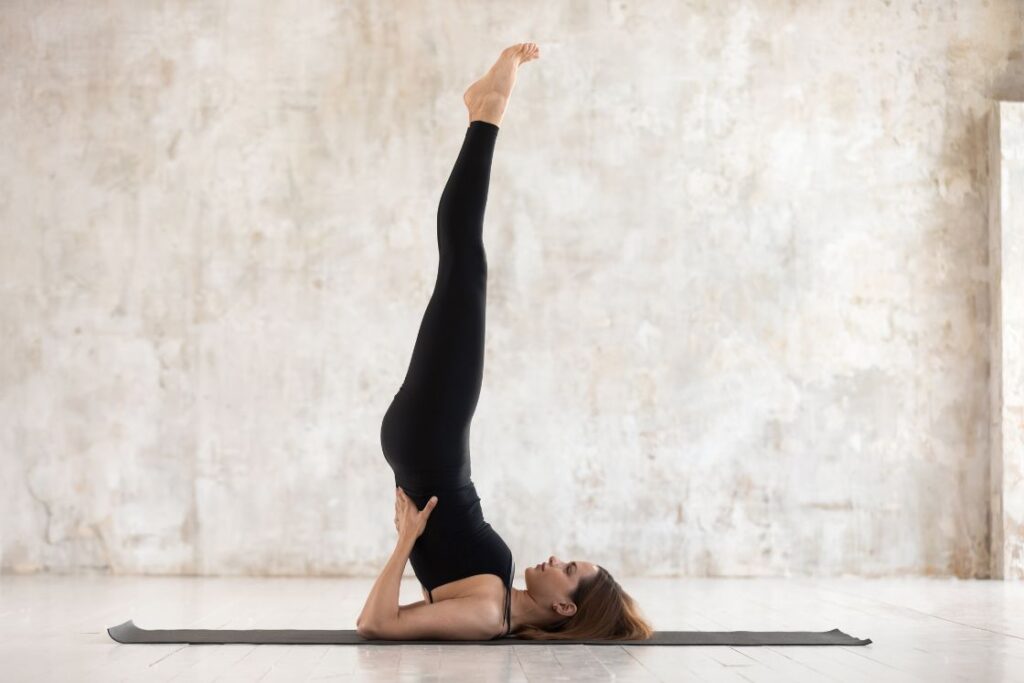
Often called the “queen” of yoga poses, Shoulder Stand is one of the most powerful asanas for improving blood circulation. It uses an inverted posture that directs blood away from the legs and towards the heart. It also strengthens leg muscles and boosts lymphatic flow. Regular practice can support hormonal balance and overall vein health.
- Lie supine on the floor
- Keep your legs joined
- Raise your legs up, and then raise your body as well.
- Work your leg muscles and abs to pull your entire body upward, and push at your hips with your hands.
- Raise up both your body and legs, inverted, with a little bend at the hip, and balance on your shoulders.
- Hold up your hips and legs with your hands for support.
- Look down at your heart
- Once you are stable in your pose, hold it for 30 seconds.
- You can go upto a minute or a couple of minutes if feeling comfortable.
To be safe practice this pose against a wall. Your head should be towards the wall as you lie down at first. When you put your body up, do not overreach with the inversion. Otherwise you can hurt your neck or spine. Your shoulders should be touching the ground.
3. Bound Angle Pose – Baddha Konasana
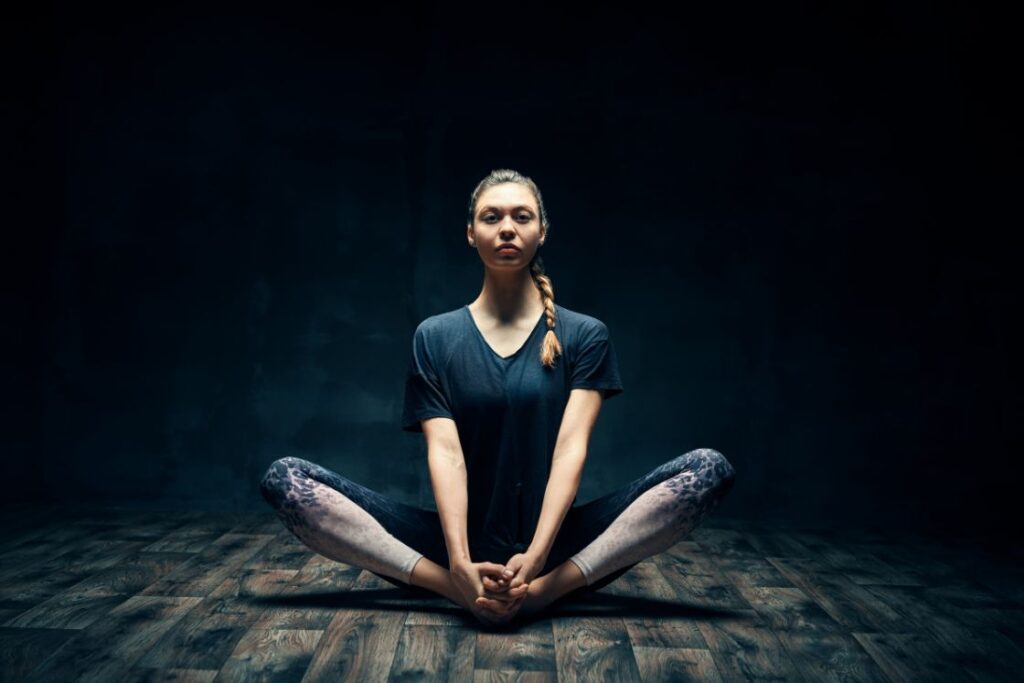
The bound angle pose puts a good exercise on your leg and groin muscles that surround your varicose veins. It improves muscle contractions. The bound angle pose will be a better solution over other poses, if you have varicose veins in your groin region. This pose also has a very potent effect on hormonal activities.
- Sit in a staff position
- Bend your knees and fold them up
- Open your knees and let them drop toward the floor on their respective sides.
- Do not let your knees touch the floor.
- Hold your knees just above the floor.
- Allow your soles to touch with each other.
- Clasp with your hands around the feet.
- Keeping your upper body erect, slightly lean forward.
- Breathe consciously, and hold the pose for 20-30 seconds.
- You can repeat this pose a comfortable few times.
In bound angle pose, you can add a layer of exercise for your muscle contraction and varicose veins. Bring your knees up together, and then again opening them on the sides. You can continue this movement throughout. Also remember not to allow your knees to touch the ground, that will put pressure on your groin.
4. Standing forward bend – Uttanasana
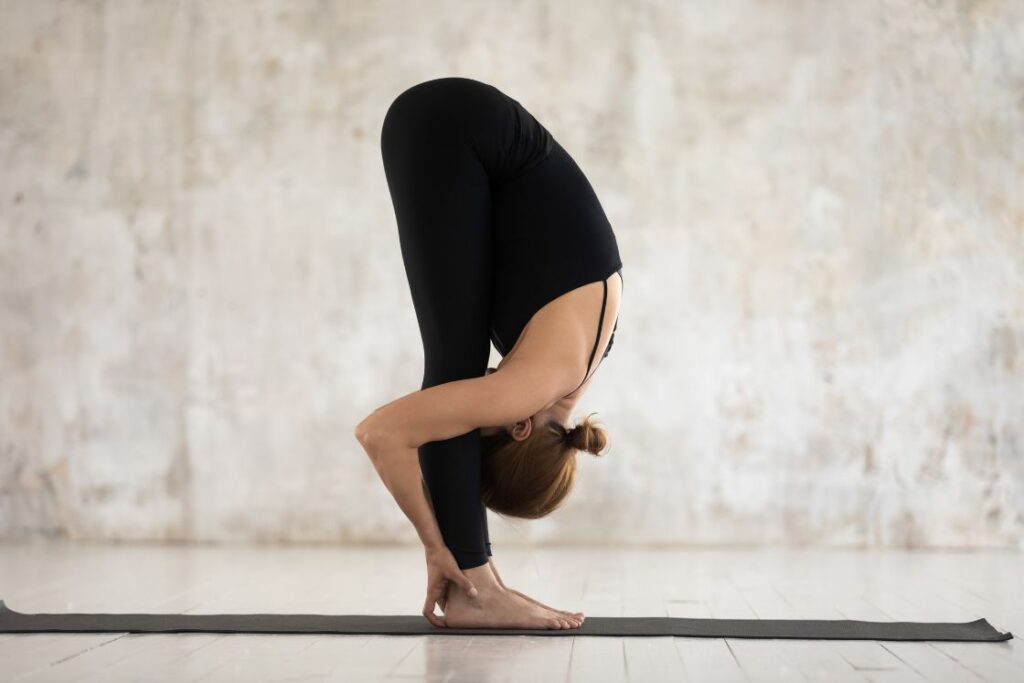
Standing forward bend puts a very strong stretch for your leg muscles. Very few other poses will help your muscles attain more must let contractions, than this pose. In cases of varicose veins in the lower leg, this pose is a must. This pose is also a go-to pose for varicose veins in the hand. Forward bend makes your blood circulation efficient.
- Stand in a mountain pose.
- Straight, spine erect, hands by the sides of your body, shoulders pressed down, head pressed back in line with the hip and feet joined.
- Raise your hands straight overhead
- Bend forward from your groin.
- Without bending your knees, bend all the way down so that your face is next to your knees and your hands are touching your feet.
- You can either hold the position for 5-7 breaths and repeat it for 3 times.
- Or hold the position for 2-3 seconds. And repeat it 5-7 times.
Try the variation with more repetitions, that will be good for your muscle contractions. Further, do not force your stretch, that could hurt your knees.
5. Thunderbolt Pose – Vajrasana
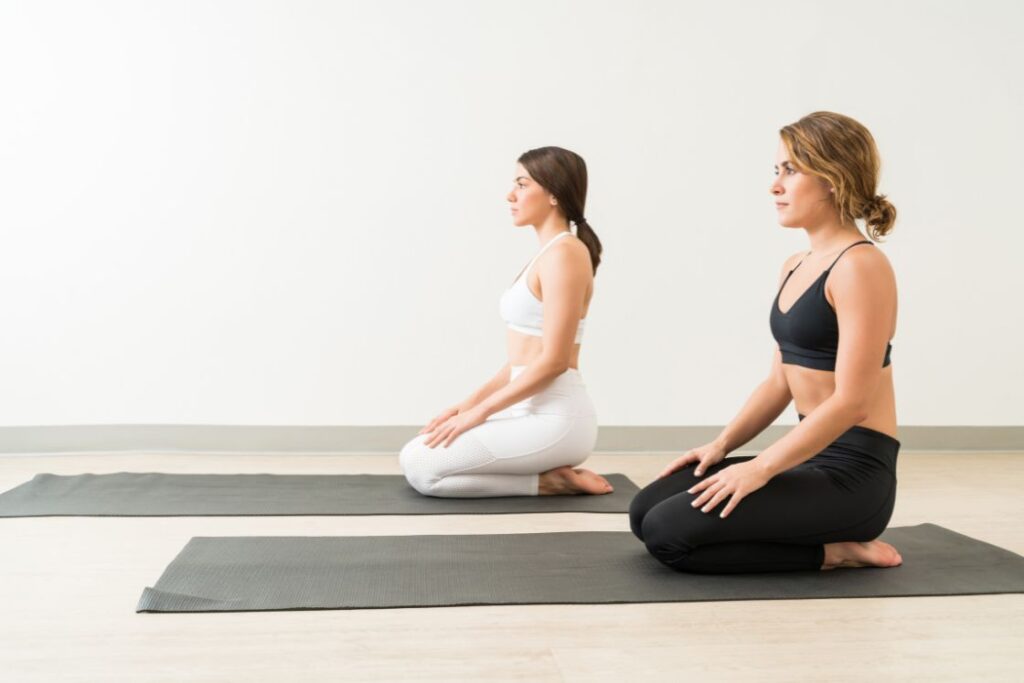
The thunderbolt pose is the pose of digestion. In varicose veins, thunderbolt pose will establish efficient nutrients absorption which will help your veins evade damage from a vicious blood flow. The sitting posture will also help the muscle contractions in your legs and groin.
- Kneel down on the floor
- Join your legs, knees and feet.
- Bend and fold your knees and sit back on your feet.
- Let your sitting bones rest on your heels and press them down.
- Keep your upper body perfectly erect.
- Rest your hands on your knees.
- Take steady breaths.
- Sit in this pose for 2-3 minutes.
- You can go upto sitting for 10 minutes if your ankles and knees permit
This posture can be easily supported by adding a folded blanket between your feet. Using it as your seat, rather then letting your heels take the entire weight. Unlike many other support modifications, this support won’t make much difference to the benefits.
6. Boat Pose – Navasana
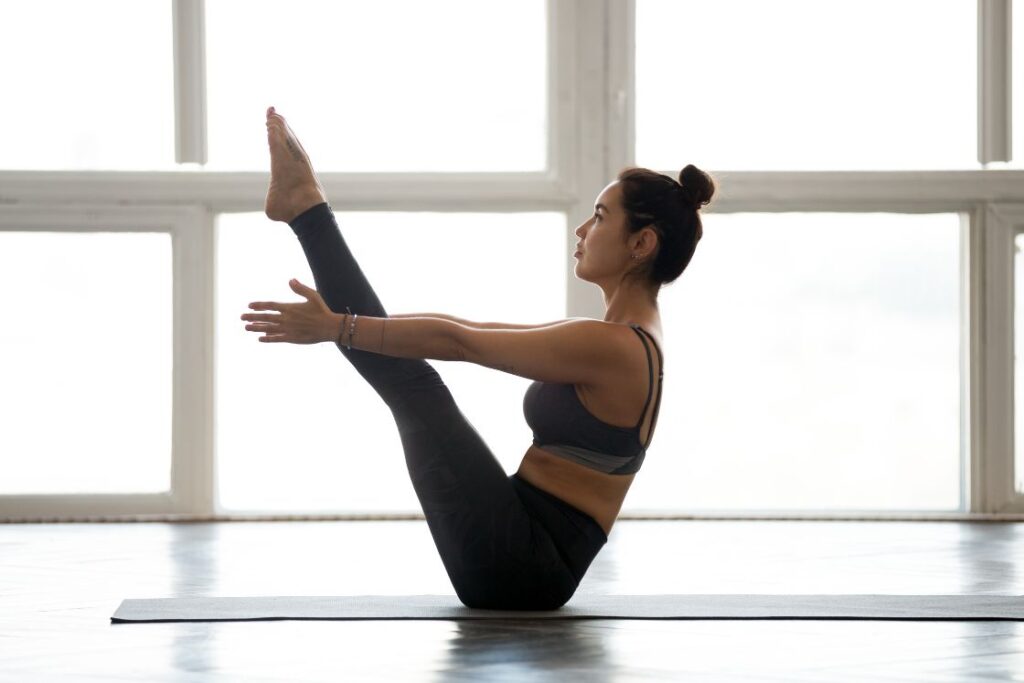
If you have varicose veins in your thighs or even groins, the boat pose will have good efficacy. The boat pose puts a fantastic exercise on your abs, hamstrings, and quadriceps. The muscle contractions provided by the boat pose, are very helpful in pumping the blood back to your heart.
- Sit in a staff pose.
- Bend your knees and fold them up.
- Hold the floor by the sides of your body.
- Gradually rock your body backward.
- Keep leaning back to a point, after which you feel like falling back.
- Hold your upper body to that point, and lift your lower legs up, keeping them parallel to the ground.
- You can balance your hands by the sides of your body, or support your thighs with them.
- Do not forget to breathe and hold the pose for 5-7 breaths.
If you are completely unable to lift your legs up, it would be because of poor hamstring strength. Which wouldn’t be uncommon in varicose veins. Thus, use your as a support under your thighs, to lift up your legs.
7. Fish Pose – Matsyasana
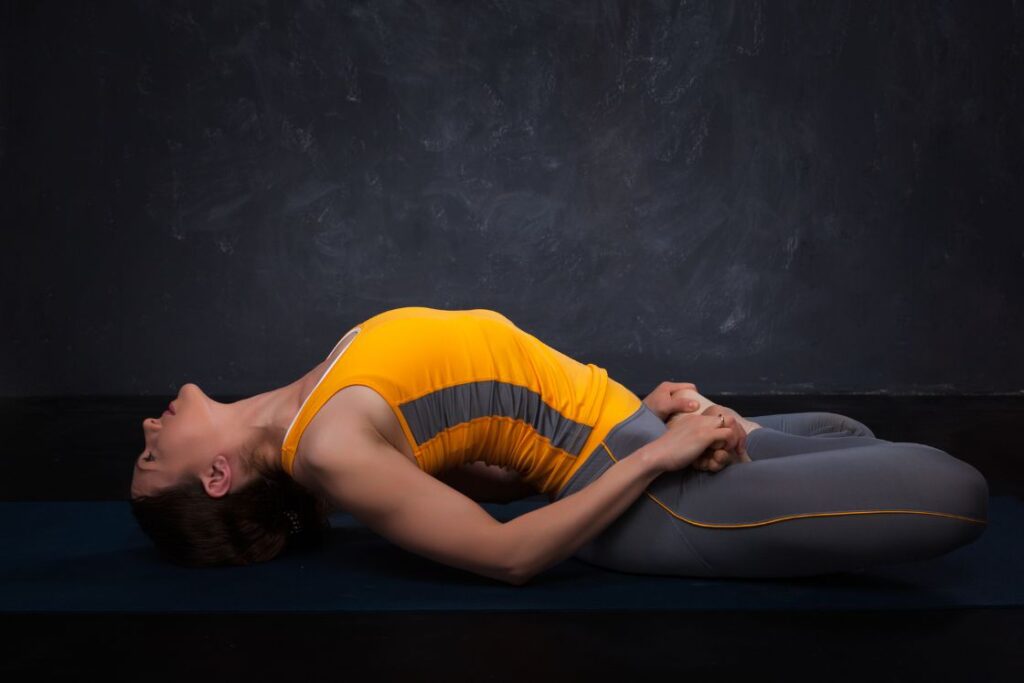
The fish pose improves the blood flow in the veins of your hands. However, the hormonal and blood circulation benefits of this pose are also quite potent. The fish pose has a strong impact on your cardiovascular health, which can have an indirect effect on varicose veins.
- Sit in a staff position.
- Recline back and rest on your elbows.
- Keep your elbows firmly pressed to the ground.
- Keep your shoulders pressed down
- Stretch and open up your chest.
- Then with an inhale push your chest out and arch your head back, and exhale.
- Keep breathing, and keep stretching your chest and expanding it outward, put your abs and lower back into this action as well.
- Then inhale and with the exhale, try to reach back with your head.
- Try and aim to touch the ground behind you with the crown of your head.
Reaching back with your head won’t come easy at first. Take time at it and even adjust your elbows recline further back, to support your head movement. You can keep your legs stretched out and joined, or fold them in a cross-legged position.
Non-yogic exercises for varicose veins
While yoga offers many benefits for varicose veins, it’s not the only way to support vein health. Adding variety to your routine can make your treatment more effective and easier to stick with. Plus, on days when you don’t have the time or energy for a full yoga session, simple movements or lifestyle practices can help improve circulation.
Here are some effective non-yogic exercises that support varicose vein relief
- Walking – Walking is a gentle, low-impact activity that promotes overall circulation. It supports blood flow, aids digestion, and helps maintain a healthy weight all important for managing varicose veins.
- Bicycling – Cycling is a great cardiovascular workout. It strengthens leg muscles and improves blood flow, especially helpful for those with weight-related vein issues.
- Swimming – Swimming works every major muscle group while reducing pressure on joints and veins. The water supports your body weight, making it easier to move and contract muscles that help pump blood upward.
- Lunges – Lunges stretch and strengthen the muscles in the thighs and calves. These leg-focused movements stimulate blood flow and support the vein valves in the lower limbs.
- Keep your legs elevated – Raising your legs above heart level allows gravity to assist in draining blood from the legs. This helps reduce swelling and pressure in varicose veins even when you’re not exercising.
- Leg lift – Leg lifts are gentle exercises that strengthen the legs and improve nerve-muscle coordination. They also enhance blood circulation without putting too much strain on the joints.
- Lower leg raises – These simple movements mimic a pumping action in the legs. They help blood move upward and prevent it from pooling in the veins.
- Ankle role – Rotating the ankles improves calf muscle flexibility and circulation. It’s a great movement to do while sitting at a desk or during long travel hours.
- Seated and standing hamstring stretches – Stretching the hamstrings reduces tension in the back of the legs and improves flexibility. These stretches support healthy blood flow, especially when practiced regularly.
- Pilates – Side lying lifts, leg circles, scissor kicks and side lying kicks are some simple but good options
- Tai Chi – Tai Chi’s slow, flowing movements enhance overall body coordination, balance, and blood circulation. Even basic routines, like the 24-form Tai Chi Chuan, can support vein health.
Yoga poses & exercises to avoid with varicose veins
Certain yoga poses that place excessive pressure on the legs or involve prolonged holding may worsen varicose veins. These include:
If you already have symptoms, it’s best to modify or avoid these poses unless guided by a trained yoga therapist.
Other exercises to avoid
While regular movement helps prevent blood from pooling in the veins, some high-impact or high-strain activities can cause more damage than relief. These include:
- Running or Sprinting – The repeated pounding motion increases pressure in the lower limbs.
- Yogic Jogging – Though light in theory, it may stress veins in the presence of existing damage.
- Heavy Weightlifting – Straining with weights can spike internal pressure, putting stress on vein walls and valves.
Why avoid these?
The reason is simple: when the legs are under extreme tension or pressure, the veins have to work harder to push blood back to the heart. This added stress can worsen valve damage and lead to further pooling of blood. Choosing low-impact exercises and gentle yoga movements is a safer and more effective way to manage varicose veins.
Conclusion
Varicose veins are a physical condition where regular movement isn’t optional it’s essential. Exercise plays a central role in managing and reducing symptoms, making it a key part of any treatment plan.
While most forms of exercise improve muscle contractions and help support blood flow, yoga goes a step further. It not only boosts circulation but also enhances digestion, balances hormones, and supports overall well-being.
Unlike many exercises that offer short-term relief, yoga has the potential to provide lasting benefits. With consistent practice, it can be a holistic approach to managing and even reversing the effects of varicose veins.
Frequently Asked Questions (FAQs)
How often should I do yoga for varicose veins?
Practise yoga 3 to 5 times a week for 15–30 minutes to improve blood flow and ease discomfort caused by varicose veins.
2. Are inversions like Shoulder Stand safe for varicose veins?
Inversions may help but should be avoided if you have severe varicose veins, high blood pressure, or neck problems. Use gentler poses like Legs Up the Wall instead.
3. Can yoga prevent varicose veins from getting worse?
Yes, regular yoga can prevent varicose veins from worsening by improving circulation, reducing vein pressure, and supporting overall vein health.
4. What else helps alongside yoga for varicose veins?
Daily walking, leg elevation, avoiding long sitting or standing, wearing compression socks, and maintaining a healthy weight support yoga in managing varicose veins.
5. Is walking better than yoga for varicose veins?
Both are beneficial. Walking improves blood flow through gentle leg movement, while yoga adds flexibility, muscle tone, and relaxation together they offer better results.
6. What causes varicose veins to flare up or get worse?
Prolonged standing, lack of movement, obesity, pregnancy, and hormonal imbalances can worsen varicose veins by increasing pressure in the leg veins.
7. Can yoga help after varicose vein surgery or treatment?
Yes, gentle yoga can aid recovery after varicose vein treatment by improving circulation, reducing stiffness, and preventing recurrence. Always follow your doctor’s advice post-surgery.

